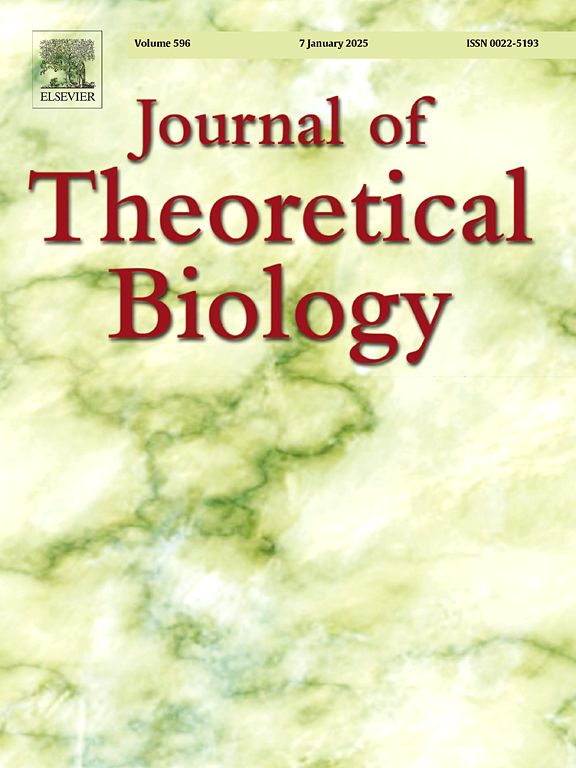Modeling pesticide impacts on honey bee dynamics from mathematical and experimental integration
IF 1.9
4区 数学
Q2 BIOLOGY
引用次数: 0
Abstract
Honey bees (Apis mellifera), essential pollinators, are critically affected by pesticides that contaminate pollen and are subsequently transported into their nests. In this study, we developed a delay differential equation model with age-specific structures, grounded in experimental data, to investigate the complex relationship between the pesticide Pristine®and honey bee population dynamics. The model enables the calculation of pollen consumption by both larvae and adults, offering deeper insights into the nutritional dynamics within hives. Our theoretical analysis revealed a significant direct linear relationship between egg and adult bee populations, determined by the ratio of adult-to-egg mortality rates, and the high death rate of adults decreases the colony population. The results indicate that adult mortality increases proportionally with pesticide concentration and alters the hive’s reproductive dynamics by shifting the timing of peak queen egg-laying. Simulations based on the model predict that high pesticide concentrations may lead to hive collapse, while control groups exhibit higher adult populations than treatment groups. These findings highlight the value of combining mathematical modeling with experimental data to understand and predict the complex effects of pesticides on honey bee populations, offering actionable insights for their conservation and management.
从数学和实验结合的角度模拟农药对蜜蜂动力学的影响
蜜蜂(Apis mellifera)是重要的传粉者,受到杀虫剂的严重影响,这些杀虫剂污染了花粉并随后被运送到它们的巢穴中。在这项研究中,我们建立了一个具有年龄特异性结构的延迟微分方程模型,以实验数据为基础,研究杀虫剂质朴®与蜜蜂种群动态之间的复杂关系。该模型可以计算幼虫和成虫的花粉消耗,从而更深入地了解蜂巢内的营养动态。我们的理论分析表明,卵和成虫种群之间存在显著的直接线性关系,这是由成虫与卵的死亡率比率决定的,成虫的高死亡率会减少蜂群的数量。结果表明,成虫死亡率随农药浓度的增加成比例增加,并通过改变蜂王产卵高峰的时间来改变蜂房的繁殖动态。基于模型的模拟预测,高浓度农药可能导致蜂群崩溃,而对照组的成虫数量高于处理组。这些发现突出了将数学模型与实验数据相结合的价值,以了解和预测农药对蜜蜂种群的复杂影响,为它们的保护和管理提供可行的见解。
本文章由计算机程序翻译,如有差异,请以英文原文为准。
求助全文
约1分钟内获得全文
求助全文
来源期刊
CiteScore
4.20
自引率
5.00%
发文量
218
审稿时长
51 days
期刊介绍:
The Journal of Theoretical Biology is the leading forum for theoretical perspectives that give insight into biological processes. It covers a very wide range of topics and is of interest to biologists in many areas of research, including:
• Brain and Neuroscience
• Cancer Growth and Treatment
• Cell Biology
• Developmental Biology
• Ecology
• Evolution
• Immunology,
• Infectious and non-infectious Diseases,
• Mathematical, Computational, Biophysical and Statistical Modeling
• Microbiology, Molecular Biology, and Biochemistry
• Networks and Complex Systems
• Physiology
• Pharmacodynamics
• Animal Behavior and Game Theory
Acceptable papers are those that bear significant importance on the biology per se being presented, and not on the mathematical analysis. Papers that include some data or experimental material bearing on theory will be considered, including those that contain comparative study, statistical data analysis, mathematical proof, computer simulations, experiments, field observations, or even philosophical arguments, which are all methods to support or reject theoretical ideas. However, there should be a concerted effort to make papers intelligible to biologists in the chosen field.

 求助内容:
求助内容: 应助结果提醒方式:
应助结果提醒方式:


